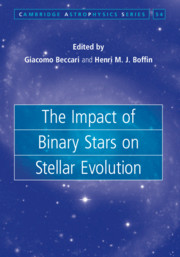Book contents
- Frontmatter
- Contents
- List of Contributors
- Foreword
- Introduction
- 1 The Zoo of Binary Stars
- 2 Statistics of Binary and Multiple Stars
- 3 Gaia and LSST: Their Importance in Binary Star Research
- 4 Population Synthesis of Binary Stars
- 5 Low- and Intermediate-Mass Star Evolution: Open Problems
- 6 The Symbiotic Stars
- 7 Binary Post-AGB Stars as Tracers of Stellar Evolution
- 8 The Importance of Binarity in the Formation and Evolution of Planetary Nebulae
- 9 Massive Star Evolution: Binaries as Two Single Stars
- 10 Binarity at High Masses
- 11 Luminous Blue Variables: Their Formation and Instability in the Context of Binary Interactions
- 12 Type Ia Supernovae: Where Are They Coming From and Where Will They Lead Us?
- 13 Binary Interactions and Gamma-Ray Bursts
- 14 Binaries as Sources of Gravitational Waves
- 15 The Impact of Binaries on the Stellar Initial Mass Function
- 16 The Formation of Binary Stars: Insights from Theory and Observation
- 17 The Maxwell’s Demon of Star Clusters
- 18 Alternative Stellar Evolution Pathways
- 19 Clocks and Scales: Playing with the Physics of Blue Stragglers
- 20 Binaries at Very Low Metallicity
- 21 Population and Spectral Synthesis: It Doesn’t Work without Binaries
- Index
21 - Population and Spectral Synthesis: It Doesn’t Work without Binaries
Published online by Cambridge University Press: 05 April 2019
- Frontmatter
- Contents
- List of Contributors
- Foreword
- Introduction
- 1 The Zoo of Binary Stars
- 2 Statistics of Binary and Multiple Stars
- 3 Gaia and LSST: Their Importance in Binary Star Research
- 4 Population Synthesis of Binary Stars
- 5 Low- and Intermediate-Mass Star Evolution: Open Problems
- 6 The Symbiotic Stars
- 7 Binary Post-AGB Stars as Tracers of Stellar Evolution
- 8 The Importance of Binarity in the Formation and Evolution of Planetary Nebulae
- 9 Massive Star Evolution: Binaries as Two Single Stars
- 10 Binarity at High Masses
- 11 Luminous Blue Variables: Their Formation and Instability in the Context of Binary Interactions
- 12 Type Ia Supernovae: Where Are They Coming From and Where Will They Lead Us?
- 13 Binary Interactions and Gamma-Ray Bursts
- 14 Binaries as Sources of Gravitational Waves
- 15 The Impact of Binaries on the Stellar Initial Mass Function
- 16 The Formation of Binary Stars: Insights from Theory and Observation
- 17 The Maxwell’s Demon of Star Clusters
- 18 Alternative Stellar Evolution Pathways
- 19 Clocks and Scales: Playing with the Physics of Blue Stragglers
- 20 Binaries at Very Low Metallicity
- 21 Population and Spectral Synthesis: It Doesn’t Work without Binaries
- Index
Summary
This chapter discusses the population and spectral synthesis of stellar populations. It describes the method required to achieve such synthesis and discusses examples where inclusion of interacting binaries are vital to reproducing the properties of observed stellar systems. These examples include the Hertzsprung–Russel diagram, massive star number counts, core-collapse supernovae and the ionising radiation from stellar populations that power both nearby HII regions and the epoch of reionization. It finally offers some speculations on the future paths of research in spectral synthesis.
Keywords
- Type
- Chapter
- Information
- The Impact of Binary Stars on Stellar Evolution , pp. 307 - 328Publisher: Cambridge University PressPrint publication year: 2019
- 1
- Cited by

